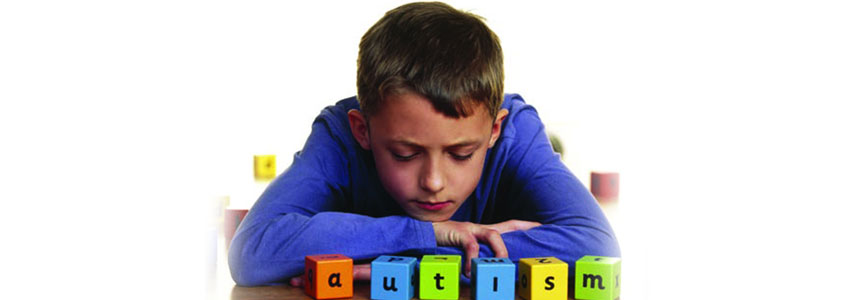What is autism?

What is autism?
Autism (sometimes called classical autism) is the most common condition in a group of developmental disorders known as the autism spectrum disorders (ASDs).
Autism is characterized by impaired social interaction, problems with verbal and nonverbal communication, and unusual, repetitive, or severely limited activities and interests.
According to recent survey by CDC (India) 1 out of every 68 children has Autism. Autism is at rise.
What are some common signs of autism?
There are three distinctive behaviors that characterize autism:
1. Difficulties with social interaction
As early as infancy, a baby with autism may be unresponsive to people or focus intently on one item to the exclusion of others for long periods of time. A child with autism may appear to develop normally and then withdraw and become indifferent to social engagement. Children with autism may fail to respond to their name and often avoid eye contact with other people. They have difficulty interpreting what others are thinking or feeling because they can t understand social cues, such as tone of voice or facial expressions, and don t watch other people s faces for clues about appropriate behavior. They lack empathy. Children with autism don t know how to play interactively with other children. Some speak in a sing-song voice about a narrow range of favorite topics, with little regard for the interests of the person to whom they are speaking.
2. Problems with verbal and nonverbal communication
They also tend to start speaking later than other children and may refer to themselves by name instead of I or me.
The hallmark feature of autism is impaired social interaction.
3. Repetitive behaviors or narrow, obsessive interests.
Many children with autism engage in repetitive movements such as rocking and twirling, or in self-abusive behavior such as biting or head-banging.
Many children with autism have a reduced sensitivity to pain, but are abnormally sensitive to sound, touch, or other sensory stimulation. These unusual reactions may
contribute to behavioral symptoms such as a resistance to being cuddled or hugged.
These behaviors can range in impact from mild to disabling. Parents are usually the first to notice symptoms of autism in their child.
Other associated conditions
Children with autism appear to have a higher than normal risk for certain co-existing conditions, including fragile X syndrome (which causes mental retardation), tuberous sclerosis(in which tumors grow on the brain), epileptic seizures, Tourette syndrome, learning disabilities, and attention deficit disorder.
For reasons that are still unclear, about 20 to 30 percent of children with autism develop epilepsy by the time they reach adulthood.
What are the early signs and symptoms?
The early signs of autism can be present under the age of one in a severely affected child. A study that looked retrospectively at videos taken during the first year of a child’s life found that a baby’s lack of response to his or her name was one of the most useful distinguishing early signs in autism. Signs in children at the more able end of the spectrum tend to be picked up later. Although their early language development may be normal they run into difficulties as social demands get greater, and may only present with problems when they get to school.
What causes autism?
Scientists aren t certain what causes autism, but it s likely that both genetics and environment play a role. Researchers have identified a number of genes associated with the disorder. Studies of people with autism have found irregularities in several regions of
the brain. Other studies suggest that people with autism have abnormal levels of serotonin or other neurotransmitters in the brain. These abnormalities suggest that autism could result from the disruption of normal brain development early in fetal development
caused by defects in genes that control brain growth and that regulate how neurons communicate with each other. While these findings are intriguing, they are preliminary and require further study. The theory that parental practices are responsible for autism
has now been disproved.
What role does inheritance play?
Recent studies strongly suggest that some people have a genetic predisposition to autism. In families with one autistic child, the risk of having a second child with the disorder is approximately 5 percent, or one in 20. This is greater than the risk for the general
population. Researchers are looking for clues about which genes contribute to this increased susceptibility. In some cases, parents and other relatives of an autistic child show mild impairments in social and communicative skills or engage in repetitive behaviors. Evidence also suggests that some emotional disorders, such as manic depression, occur more frequently than average in the families of people autism
Do symptoms of autism change over time?
For many children, autism symptoms improve with treatment and with age. Some children with autism grow up to lead normal or near normal lives. During adolescence, some children with autism may become depressed or experience
behavioral problems.
Tips to Parents and Teacher for working with children with Autism
1.Make sure directions are given step by step verbally and visually
and by providing physical supports or prompts, as needed by
the child
2. Indivisuals with autism oftenhave trouble interpretating facial expressions, body language, and toneof voice. Be as concrete and explicit as possible in
your instructions and feedback to the student.
3. Find out what the indivisuals strength are andemphasize them. Tap into those avenues and create opportunities for success.
4.Positive feedback and lot of opportunities and practices.
5. Have consistent routines and schedules. If you know of change in routine inform the child in advance to prepare him for the change.
Useful Links:
http://en.wikipedia.org/wiki/Autism
